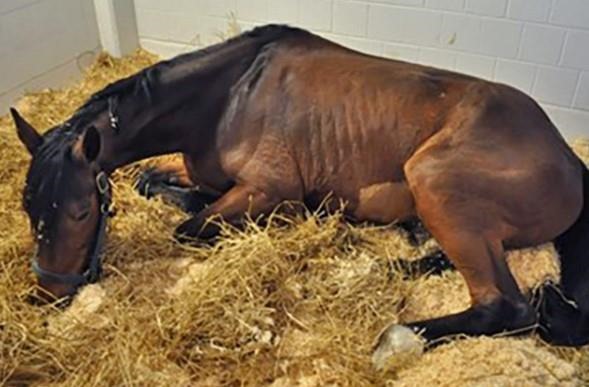The clinical signs of botulism vary in severity depending on the amount of toxin ingested
- The main sign is generalized weakness that may progress to complete paralysis. This may start off looking like a stiff, stilted gait but progress to muscle tremors, weakness, and eventually recumbency (inability to rise).
- Some affected horses may just spend more time lying down.
- Other signs of paralysis involve the eyelids and tongue. When looking closely at the eyes, the pupils will be dilated and the blink will be weak. The horse often has trouble chewing and swallowing.
- Once the horse is recumbent, issues with bladder paralysis and colic can result.
- Ultimately, horses may die due to paralysis of the respiratory muscles.
- One important thing to note that helps differentiate this disease from other neurologic diseases is that the horse’s mentation (mental activity) will be normal. They will be aware of their surroundings and often want to eat.

A horse with botulism displaying signs of generalized weakness including laying down and resting chin on ground. Credit: Sally DeNotta, UF/IFAS
How is botulism diagnosed?
Botulism is diagnosed based on known risk factors and clinical signs. There is no blood test for botulism. As many horses with botulism have difficulty eating, a grain test can easily be performed to help make a diagnosis. Give 8 oz. of grain in a pan, and a normal horse should be able to eat it in less than 2 minutes. If they take longer, that may be a sign of botulism, especially if they have other signs of weakness or recumbency. Feces, contents of the gastrointestinal tract, and hay samples from affected farms can be tested for toxin to confirm the diagnosis. If the horse does not survive, a post-mortem exam will usually not find anything obviously abnormal.
How can you protect your horses against botulism?
- Inspect all hay before feeding. Never feed hay that looks moldy or rotten, and discard any bales found to contain rodents or other dead animals. Avoid feeding round bales, block hay, or silage to horses, as these types of forages are more difficult to screen for trapped dead animals. The safest feeding practice is to feed good quality baled hay and avoid haylage, round bales, and other types of hay that are better off fed to other livestock. When you’re feeding small bales, you can visually inspect each flake as you feed so if there’s excessive moisture, weed contamination or mold, or if an animal was trapped in the baling process, you can discard that bale without feeding it.

A hay bale containing parts of deer carcass inadvertently trapped during baling. Carcasses are sources of botulism Type C in horses. Credit: UF/IFAS Photo Archive
- Watch for signs: Horses laying down more than usual, particularly if more than one horse is involved; muscle tremors; weakness resulting in inability to stand; loss of tongue control; inability to swallow resulting in drooling and difficulty eating and drinking; stiff, short stride or stumbling gait; and loss of tail tone. Oftentimes, horses are found dead in the pastures.
- If you notice signs, call your veterinarian immediately. The only effective treatment for botulism is administration of botulism antitoxin. The antitoxin works on all three types of botulism, and one dose of antitoxin will circulate long enough to eliminate any free toxin. It doesn’t, however, have any effect on toxin that is already bound to the neuromuscular junctions – so it’s critically important to administer the antitoxin as early as possible, ideally before the horse becomes too weak to stand.
- Ask your veterinarian if vaccination is right for your horse. If you live in a region endemic for botulism (Kentucky and Mid-Atlantic), or if you feed types of hay known to be high-risk for botulism, preventative vaccination for Type B may be helpful. However, that vaccination is not likely to be helpful in an outbreak situation, and is not effective against Types A or C.
Unfortunately prophylactic testing of hay is not helpful
In an outbreak situation, it is natural to want to test hay for this deadly toxin to prevent your horses from potential exposure. Unfortunately, because the toxin can be distributed very sporadically throughout only some bales within a batch of hay, or even in only certain areas within a single bale, there’s really no way to take a single hay sample and accurately assess your horse’s risk. Feces, intestinal contents and feed from horses we know are clinically affected can confirm the diagnosis and determine the type of botulinum toxin involved, but there’s no reasonable way to screen a batch of hay to know it’s safe for your horses.
Source : ufl.edu